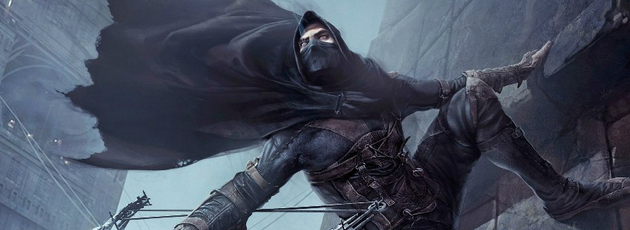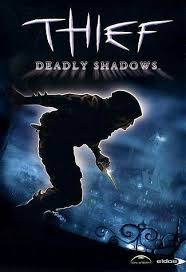Things were better before : Thief
09
This article was published Nov. 15th, 2013, on LeBlogJeuVidéo.be, a french-speaking video game blog, and created by Yours Truly, co-authored by the incredible Washisama. Some facts may be outdated.

Infiltration… Metal Gear, Splinter Cell… all seminal works of the “Stealth Game” category, where combat gets seriously toned down, and should be avoided altogether in most cases. In the beginning, stealth games were often played in the third person. The very first Metal Gear, on consoles, displayed a top-down view : the player had a major advantage over his opponents because he could “see beyond” his played character’s normal field of view, and gain an instinctive knowledge of his surroundings. . But that all changed in 1998 …
Indeed, EIDOS published what was going to be the very first FPS-Infiltration game: Thief – the Dark Project, created by Looking Glass Studios. No more wide angles of view around the player character: we were projected into the skin of Garrett, evolving in a medieval universe strongly marked by the industrial revolution and a Steampunk aesthetic. Garret, master thief with a mysterious, shrouded past, steals for his own good but also accepts outside jobs, stealing for wealthier mob figures, until the day one of these clients proposes a contract : steal a certain artifact with mystical qualities …
Very quickly, Garret gets thrown into the role of a pawn, played by several factions in a fight for good against chaos. And it’s up to the player to guide him, from mission to mission in settings ranging from pure and simple medieval mansion heists to more horror-themed locales, like catacombs. Thief pushed the boundaries of our gaming rigs, be it in the still nascent 3D accelerated graphics, but also at the sound level: for the first time, the player had to use his hearing in addition to his sight to spot the guards (and other enemies much less human!) and avoid them by hiding in the shadows. It introduced the concept of NPC banter, which on top of being able to localize a guard before you even see him, added a sense of humor to the otherwise tense gameplay. Garret is almost invisible in the shadows, so moving among those was paramount; so was the player noise (the steps of our master thief are more or less pronounced, depending on the surface he treads, as well as the speed of motion. For first time, spatial positioning of noises and their detection became an integral part of the gameplay, and as long as we had the adequate hardware, the immersion was total.
To advance and succeed in his “misdeeds”, Garret has a whole arsenal at his disposal: normal arrows to eliminate the guards at a distance, a blackjack club to knock them out in melee; water arrows (to extinguish torches from a distance, in order to create more shadow areas), moss arrows to cover floors with a vegetation that muffles footsteps) …
And the difficulty can be adjusted: at the easy level, Garret can manage by playing a little rough, killing and knocking out guards as he sees fit .. but in the higher difficulty levels, no more brute force approach : the game objectives won’t allow killing the guards, there’s a set goal to stealing a certain amount of objects or find rare hidden items … while also increasing the aggressiveness and awareness of the guards…

Two years later, Thief received his first sequel – subtitled The Metal Age. Following the traumatic events of the first installment, which saw the emergence (and destruction) of a doomed deity, the Thief universe shifted into high gear (no pun intended), as development of industry and decline of magic rang the dawn of the Metal Age. In terms of gameplay, ther was very little change, except that the levels were now perfect challenges at the level of infiltration and stealth, unlike in the first game where there was still a lot of brute force sequences possible. The story, meanwhile, was the logical continuation of the first episode : this time, Garret had to fight a religious fanatic who worshipped a machine god bent on elimination of all biological life…
You have to have played these two masterpieces to understand the incredible atmosphere that permeates the gamepla … borderline creepy, with extremely discreet sound effects and an ambien music score, giving an almost dreamlike vibe… especially in missions where Garret has to explore ruins, abandoned crypts, or other lairs of eldritch entities. Because even if the story begins down to earth with doing heists in the palaces of the rich, very quickly the influence of the forces of chaos will cause the supernatural and fantastic to take over …

Four years later, in 2004, Eidos released Thief: Dark Shadows, this time produced by Ion Storm. Running with the same graphics engine as Deus Ex 2 (released in 2003), this Thief 3 was sort of a “reboot” of the series .. and just like Deus Ex 2, having been developed for PC and consoles at the same time, shared the same shortcomings of console-to-PC ports of that epoch : smaller levels, missions split into several levels with increased loading times… But we let’s not dwell on these problems (which were more obvious in Deus Ex 2 anyway). There were improvements : Unreal graphics engine, new management of artificial intelligence, possibility to explore the whole city between missions where the plot unfolds. The plot, mixed the strong points of the first two episodes: order, represented by the forces of the Hammerites, in combat with the forces of Chaos, represented by the Pagans .. and right in the middle of that, Garret, supported by the Guardians, a third faction playing a determining role for our master thief…
Once again, the atmosphere was even more polished, the story gripping, Deadly Shadows gave us also of one of the most terrifying mission levels in video game history: the exploration of the haunted orphanage of Shalebridge Cradle !
For many gamers, however (and this was to remain a constant for this first generation of next-gen games), the damage was done: it was obvious that the games were optimized for console; the PC version was sub-par, an often badly optimized port.
Fortunately, you could count on the community of fans who created a level editor, and a smorgasbord of impressive mods, making the games even more difficult or realistic. Icing on the cake, The Dark Mod: a total conversion to run Thief with the graphics engine of Doom 3, completely free.
Which brings us to 2014 and the release of Thief 4. Delayed many times, were treatad to a “real” reboot of the series, always with our valiant thief Garett, of course, but independent of the three previous chapters and with a completely new “next-gen” graphics engine; addition of a skill system, streamlined gameplay with implementation of a “focus” mode (already seen on Hitman: Absolution) which slows down time and highlights certain objects useful for the exercise of his profession …
This streamlining (especially in traversing the City) was a big point of content to the fans of the series, who believed that the gameplay had been casualized for console, as seen in other reboots of other game series like Tomb Raider or Hitman.
The focus mode raised the most ire. Where the series initially immersed us in Garret’s very quite limited sensorium, focus mode allowed Garret to sense guards through walls, or gets an optimized path to his objective highlighted… While fans of the original had to remember sequences of deep anguish, lurking in the shadows, avoiding guards whose footsteps could only be heard…
Another point of note: similarities to Dishonored, especially in terms of gameplay. “Normal”, according to the developers, since Dishonored had also “stolen” a lot of things from the original first two Thief games…
Finally, we got a toned-down reboot of the cherished series, and only by tweaking the quite extensive difficulty settings, gamers were able to hark back to the tension of the original games.